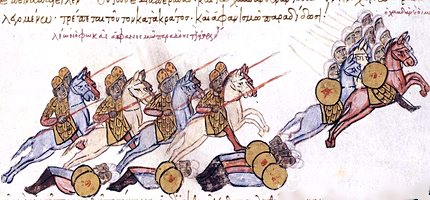
Battle of Andrassus(Andrasos) |
year: 9608 November 960 |
| A decisive Byzantine victory which marked a new era in the Arab wars | ★ ★ ★ ★ ★ |
|
enemy: Arabs
|
location: In the passages of the Cilician mountains, in south Asia-Minor
|
accuracy:
●●●●●
|
|
battle type: Ambush |
war: Later Byzantine-Muslim Wars |
modern country:
Turkey |
| ▼ The Byzantines(emperor: Romanos II) | ▼ The Enemies | |
| Commander: | General Leo Phokas | Emir Sayf al-Dawlah |
| Forces: | outnumbered | 30,000 |
| Losses: | Almost all perished |
| Background story: |
| During the reign of Emperor Romanos II (959-963) the main enemies of Byzantium in the East were the Hamdanid Arabs and their emir Sayf ad-Dawlah, based in Aleppo. In July 960, general Nikephoros Phokas assembled a large army -mostly from the units of Asia Minor- and invaded Crete. This altered the balance of forces in the eastern front and Sayf ad-Dawlah took the opportunity to launch large-scale raids into the Byzantine Anatolia. Emperor Romanos II transferred Leo Phokas, Nikephoros’ brother, in the East to deal with the situation, but this did not discourage the Emir, who leading an army of 30,000 moved against the fortress of Chrisianon, in the autumn of 960. Leo Phokas being unable to confront the Arabs in open battle, preferred to organize an ambush in the rear of the Arabs, at the straits of Andrassus, in Cilicia. |
The Battle: |
 The battles of Andrasos in Skylitzes manuscript They were trapped in the passage and completely routed. It was an overwhelming defeat of the Arabs; the Byzantines annihilated most of the enemy forces, while the emir himself barely managed to escape. |
Aftermath: |
| It was a turning point in the long conflict between Byzantines and Arabs in the East. The victory enabled the Byzantines to finish the conquest of Crete and started the decline of the Hamdanids who were no longer in position to raid in Anatolia. |
|
|
